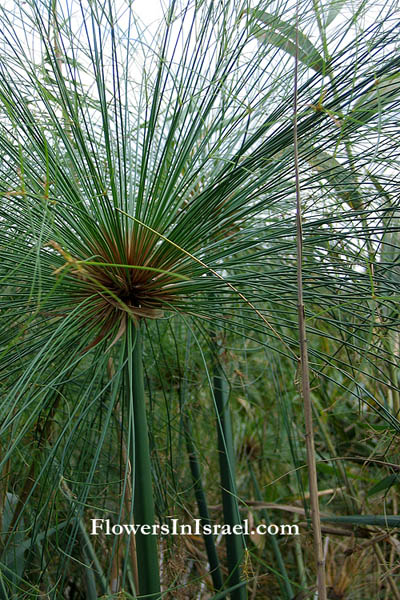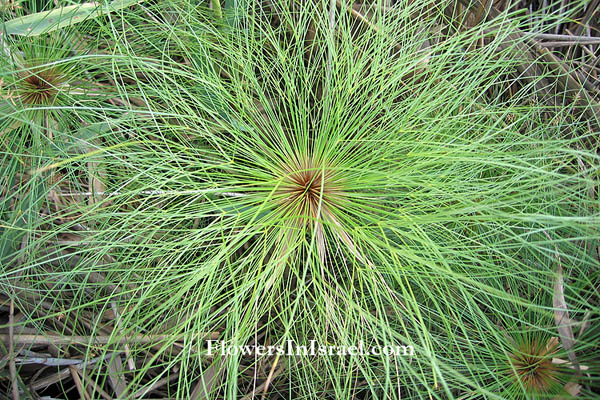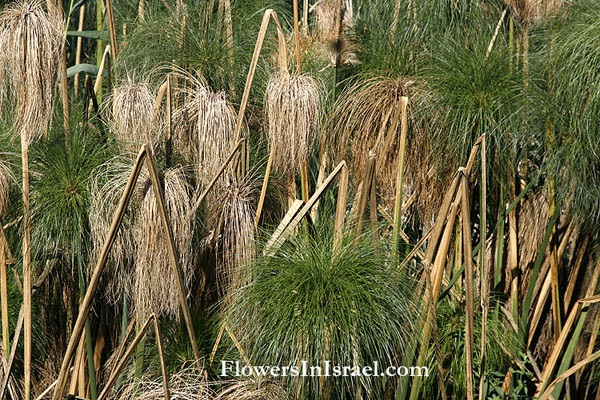
Derivation of the botanical name:
Cyperus, kyperos, kypeiros "galingale, sedge"; Latin cyperos, the name cyperis, idis was applied by Plinius to the root of the Cyperus.
papyrus, παπυροϛ, paper.
The Hebrew words referring Cyperus papyrus are גומא, “gômê” or”gomeh” (Greek, θίβη, meaning “ark or wicker basket”, πάπυρος, meaning “papyrus”) and עָרוֹת, “aroth” or “arot” (Greek, τό άχι τό χλωρόν), rendered “meadows” in the English Revised Version of the Bible.
- The standard author abbreviation L. is used to indicate Carl Linnaeus (1707 – 1778), a Swedish botanist, physician, and zoologist, the father of modern taxonomy.
Cyperus papyrus supplied the earliest known paper.
Herodotus, a Greek historian (approx. 484 BCE - 425 BCE), the History, BookII.92: The Egyptians, who live in the marshes... The papyrus, which grows yearly there, they draw out of the marshes; the upper part of ot they cut off and use for other purposes, but the lower part, to the lenght of one cubit (about half a metre), they eat; they sell it, as well. Those who want to have papyrus at its best bake it in a redhot oven and eat it.
John Gerard (1545 – 1611/12), an English botanist, wrote in the Herball: "The kind of Reed, which I have Englished Paper Reed, or Paper Plant, is the same (as I do read) that Paper was made of in Egypt, before the invention of paper made of linen clouts was found out. It is thought by men of great learning and understanding in the Scriptures, and set down by them for truth, that this plant is the same Reed mentioned in the second chapter of Exodus, whereof was made the basket or cradle, which was daubed within and without with slime of that country called bitumen judaicum, wherin Moses was put being committed to the water, when Pharaoh gave commandment that all the male children of the Hebrews should be drowned."
H.B.Tristram (Nat. Hist. of the Bible, 1882) says: 'It grows very luxuriantly in a swamp at the nort end of the Plain of Gennesaret, close to the fountain of Ain et Tin, and it covers many acres in the inaccessible marshes of the Huleh, the ancient Merom; and is known to the Arabs by its old name, 'babeer,' of which 'papyrus' is simply the Latinized form...
H.B.Tristram describes the preparation of paper as very simple: "The stems were first pared, and the pith cut lengthwise into thin slices, which were laid side by side on a flat board. Other slices were laid across them at right angles, their surfaces being cemented together by a sort of glue. They were then subjected to great pressure and thoroughly dried, when the manufacture was completed".
Bible Resources:
- Exodus 2:3
But when she could hide him no longer, she got a papyrus basket for him and coated it with tar and pitch. Then she placed the child - Job 8:11
Can papyrus grow tall where there is no marsh? Can reeds thrive without water?
- Job 9:26
They skim past like boats of papyrus, like eagles swooping down on their prey.
- Isaiah 18:2
which sends envoys by sea in papyrus boats over the water. Go, swift messengers, to a people tall and smooth-skinned, to a people feared far and wide, an aggressive nation of strange speech, whose land is divided by rivers.
- Isaiah 35:7
The burning sand will become a pool, the thirsty ground bubbling springs. In the haunts where jackals once lay, grass and reeds and papyrus will grow.

|


